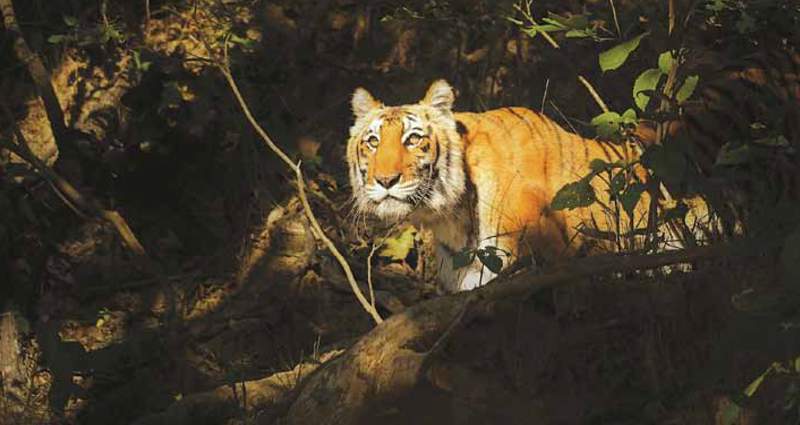
Tigers love shade and coolness – Sharmili, Corbett Tiger Reserve
By Nirmalya Chakraborty
Being Sher Khan
My glorious years of active tiger tracking out in the Indian wilderness have provided me with some of the greatest opportunities to record and document intimate moments from the life of tigers.
Using photography and filming as a powerful tool to communicate my story effectively, this is a lovely journey of rediscovering our most popular – ‘Sher Khan’.

Tiger make the jungle vibrant with life – Tigress Sonam with cub, Tadoba Andhari Tiger Reserve

“Mom and Me” – Tigress Dotty with cub, Bandhavgarh Tiger Reserve

Get scolding from mom –Arrowhead with Riddhi and Siddhi, Ranthambore Tiger Reserve



Tiger fight for space and mates, Dotty sub adults on the verge of separation, Bandhavgarh Tiger Reserve

Tigers hunt for Living, Tigress Dotty, Bandhavgarh Tiger Reserve

Tigers Love Water

Tigers also Romance – Maya and Katezari Male, Tadoba Tiger Reserve

Tigers are social animals – Tiger Family, Kolsa – Tadoba Andhari Tiger Reserve

Father and Daughter – Tiger Bheem with cub, Bandhavgarh Tiger Reserve

Sibling Love – Dotty cubs show their love, Bandhavgarh Tiger Reserve
The Final Word
Tiger is a live indicator of our ecosystem’s health. Tigers do not settle in places where habitat is not conducive. A tiger cannot live in places where forest cover,prey species and water sources
have vanished. Saving the tiger would mean saving a large track of forest which it needs to survive.
A tiger feeds around 18-40kg of meat in a single feed, starting from the rump. Without interruption, it may take around 3-6 days to finish the meal. In India, it is estimated that if a single tiger hunts every 8-9 days, then on an average a tiger would need about 54 ungulates each year. To make sure that there is adequate prey base for sustainability, woodlands, grasslands, meadows and water streams that these prey animals need to survive have to be protected. In this way, the entire forest ecology from the forest floor to the canopy and all its denizens – algae, ants, termites, bees, spiders, frogs, bats, birds & fishes all become secure under the initiatives of tiger conservation. Forests also act as air and water purifiers and help maintain groundwater levels and protect
against soil erosion, by destroying the tiger’s home, we not only harm tigers and wildlife, but also ourselves. Saving it, is providing ourselves with a clean environment and securing a better future.
Tiger has thus become the umbrella species for wildlife conservation in India. When a forest is protected, along with the tiger, the entire ecosystem that it encompasses comes under the protected jurisdiction.
Tigers are mega-fauna whose presence itself instils a feeling of respect and admiration. It is human nature to get attracted thus help in creating the instant attention that is vital for conservation
awareness. Awareness is then all about creating the love for nature, help appreciate our beautiful natural world and then inspire to participate in conservation action. Publication of interesting facts and easily understandable content on conservation help in being conscious about what role a species play in our entire cycle of life and why conservation is important.
Conservation action comes naturally with acceptance and adoption. Media play a pivotal role in wildlife conservation.
Successful conservation stories help to maintain confidence on future conservation projects and initiatives. News drives human perceptions and leads to false interpretations. Reporting of ‘stray
incidents’ of tiger-human conflict must be done responsibly and with due care. Animal conflicts are ‘individual’ specific issues and not a behavioural aspect of a species as a whole. A successful conservation program can be easily derailed by misreporting of facts. Reporters must be sensitized on the complexities of conservation, environmental and wildlife reporting before they can operate. Let us live an eco-sensitive life and help to keep the tigers safe in our jungles!

Tiger Bheem, Bandhavgarh Tiger Reserve
About Author:
Nirmalya Chakraborty is a passionate nature lover and a wildlife explorer. He has travelled to various global pristine habitats and has documented unknown animal behaviour and key issues of
conservation through strong storytelling and photojournalism. He has travelled to the Yellowstone to photograph wolves’ behaviour, tracked the rare Hawaiian goose in the volcanic islands of Hawaii, embarked upon an expedition up to the Alaskan Arctic and studied impacts of climatic change on the last remaining Beaufort Sea population of polar bears. His oceanic quests have been on the migratory humpback whales in the North Atlantic Ocean.
He is currently researching on migration of elephants and tigers in deep ‘dark’ woodlands of India. He is the editor of Jungle Rhythms magazine which is committed to providing wildlife conservation awareness to the civilians who are unaware of the degradation in the wild. His photographs has won various international awards as National Geographic and exhibited in many international exhibitions and published in books, magazines and research papers.




